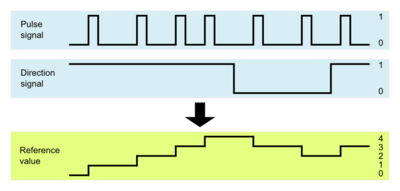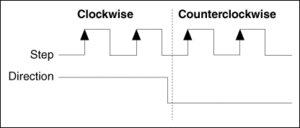Difference between revisions of "Pulse and direction"
From Granite Devices Knowledge Wiki
| [quality revision] | [checked revision] |
| (2 intermediate revisions by the same user not shown) | |||
| Line 1: | Line 1: | ||
| − | [[File:Pulse and direction wiki.png|thumb|Pulse and direction signals|400px]] | + | [[File:Pulse and direction wiki.png|thumb|Pulse and direction signals and a setpoint value (reference)|400px]] |
| − | '''Pulse and direction''', '''step and direction''' or '''pulse train''' refers to digital signaling type used in position control. Pulse & dir is famous from stepping motor drives but it also can be used in many servo drives as position or velocity [[ | + | '''Pulse and direction''', '''step and direction''' or '''pulse train''' refers to digital signaling type used in position control. Pulse & dir is famous from stepping motor drives but it also can be used in many servo drives as position or velocity [[setpoint signal]]. |
==Principle== | ==Principle== | ||
| + | [[File:Stepdir.gif|300px|thumb|Pulse and direction signals]] | ||
Pulse & dir contains two digital signal lines: | Pulse & dir contains two digital signal lines: | ||
| − | * Pulse - a signal that will control motion distance & speed | + | * Pulse (or step) - a signal that will control motion distance & speed |
* Direction - a signal that will control direction of motion | * Direction - a signal that will control direction of motion | ||
| − | Pulse has constant distance increment, i.e. 1/1000 of revolution. So to rotate motor one revolution it takes 1000 pulses. To rotate in reverse direction, direction signal state is changed. | + | |
| + | Position setpoint is changed by one count by rising edge of pulse signal and the direction of change is determined by the state of direction signal during the edge. Pulse has constant distance increment, i.e. 1/1000 of revolution. So to rotate motor one revolution it takes 1000 pulses. To rotate in reverse direction, direction signal state is changed. | ||
[[Category:Signals]] | [[Category:Signals]] | ||
| + | [[Category:Glossary]] | ||
Latest revision as of 11:53, 31 March 2015
Pulse and direction, step and direction or pulse train refers to digital signaling type used in position control. Pulse & dir is famous from stepping motor drives but it also can be used in many servo drives as position or velocity setpoint signal.
Principle[edit | edit source]
Pulse & dir contains two digital signal lines:
- Pulse (or step) - a signal that will control motion distance & speed
- Direction - a signal that will control direction of motion
Position setpoint is changed by one count by rising edge of pulse signal and the direction of change is determined by the state of direction signal during the edge. Pulse has constant distance increment, i.e. 1/1000 of revolution. So to rotate motor one revolution it takes 1000 pulses. To rotate in reverse direction, direction signal state is changed.

